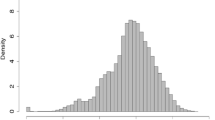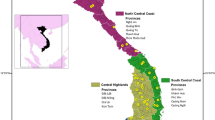Abstract
Key message
High-throughput markers, such as SNPs, along with different methodologies were used to evaluate the applicability of the Bayesian approach and the multivariate analysis in structuring the genetic diversity in cassavas.
Abstract
The objective of the present work was to evaluate the diversity and genetic structure of the largest cassava germplasm bank in Brazil. Complementary methodological approaches such as discriminant analysis of principal components (DAPC), Bayesian analysis and molecular analysis of variance (AMOVA) were used to understand the structure and diversity of 1,280 accessions genotyped using 402 single nucleotide polymorphism markers. The genetic diversity (0.327) and the average observed heterozygosity (0.322) were high considering the bi-allelic markers. In terms of population, the presence of a complex genetic structure was observed indicating the formation of 30 clusters by DAPC and 34 clusters by Bayesian analysis. Both methodologies presented difficulties and controversies in terms of the allocation of some accessions to specific clusters. However, the clusters suggested by the DAPC analysis seemed to be more consistent for presenting higher probability of allocation of the accessions within the clusters. Prior information related to breeding patterns and geographic origins of the accessions were not sufficient for providing clear differentiation between the clusters according to the AMOVA analysis. In contrast, the F ST was maximized when considering the clusters suggested by the Bayesian and DAPC analyses. The high frequency of germplasm exchange between producers and the subsequent alteration of the name of the same material may be one of the causes of the low association between genetic diversity and geographic origin. The results of this study may benefit cassava germplasm conservation programs, and contribute to the maximization of genetic gains in breeding programs.






Similar content being viewed by others
References
Arnaud J-F, Cuguen J, Fénart S (2011) Metapopulation structure and fine-scaled genetic structuring in crop-wild hybrid weed beets. Heredity 107:395–404
Benesi IRM, Labuschagne MT, Herselman L, Mahungu N (2010) Ethnobotany, morphology and genotyping of cassava germplasm from Malawi. J Biol Sci 10:616–623
Botstein D, White RL, Skolmick H, Davis RW (1980) Construction of a genetic linkage map in man using restriction fragment length polymorphism. Am J Med Genet 32:314–331
Carvalho LJCB, Schaal BA (2001) Assessing genetic diversity in the cassava (Manihot esculenta Crantz) germplasm collection in Brazil using PCR-based markers. Euphytica 120:133–142
Chagné D, Batley J, Edwards D, Forster JW (2007) Single nucleotide polymorphisms genotyping in plants. In: Oraguzie N, Rikkerink E, Gardiner S, De Silva H (eds) Association mapping in plants. Springer, New York, pp 77–94
Chao S, Zhang W, Akhunov E, Sherman J, Ma Y, Luo M, Dubcovsky J (2009) Analysis of gene-derived SNP marker polymorphism in US wheat (Triticum aestivum L.) cultivars. Mol Breed 23:23–33
Cieslarová J, Hýbl M, Griga M, Smýkal P (2012) Molecular analysis of temporal genetic structuring in pea (Pisum sativum L.) cultivars bred in the Czech Republic and in former Czechoslovakia since the Mid-20th century. Czech J Genet Plant Breed 48:61–73
de Bang TC, Raji AA, Ingelbrecht IL (2011) A multiplex microsatellite marker kit for diversity assessment of large cassava (Manihot esculenta Crantz) germplasm collections. Plant Mol Biol Rep 29:655–662
Devi AKB, Gin G, Rahul Y (2009) Assessment of genetic diversity in cassava (Manihot esculenta Crantz) germplasm. J Root Crops 35:108–111
Dixon AGO, Bandyopadhyay R, Coyne D, Ferguson M, Shaun R, Ferris B, Hanna R, Hughes J, Ingelbrecht I, Legg J, Mahungu N, Manyong VMD, Neuenschwander P, Whyte J, Hartmann P, Ortiz R (2003) Cassava: from poor farmers’s crop to pacesetter of African rural development. Chron Hortic 43:8–15
Doyle JJ, Doyle JL (1990) Isolation of plant DNA from fresh tissue. Focus 12:13–15
Doyle M, Pujol B, Elias M (2001) Ecology and genetics of populations of cassava managed by Amazonian Amerindians: or, how to maximize the benefits and minimize the costs of outcrossing in a vegetatively propagated crop. In: Fauquet C, Taylor NN (eds) Proc 5th int scientific meeting of the cassava biotechnology network. Danforth Plant Science, Missouri
Elías M, Panaudà O, Robertà T (2000) Assessment of genetic variability in a traditional cassava (Manihot esculenta Crantz) farming system, using AFLP markers. Heredity 85:219–230
Elías M, Penet L, Vindry P, Mckey D, Panaud O, Robert T (2001) Unmanaged sexual reproduction and the dynamics of genetic diversity of a vegetatively propagated crop plant, cassava (Manihot esculenta Crantz), in a traditional farming system. Mol Ecol 10:1895–1907
Ersoz ES, Yu J, Buckler ES (2007) Applications of linkage disequilibrium and association mapping in crop plants. In: Varshney RK, Tuberosa R (eds) Genomics-assisted crop improvement. Springer, Dordrecht, pp 97–119
Evanno G, Regnaut S, Goudet J (2005) Detecting the number of clusters of individuals using the software structure: a simulation study. Mol Ecol 14:2611–2620
FAO (2012) FAOSTAT database. FAO, Italy (Accessed 26 June 2012)
Ferguson ME, Hearne SJ, Close TJ, Wanamaker S, Moskal WA, Town CD, Young J, Marri PR, Rabbi IY, Villiers EP (2012) Identification, validation and high-throughput genotyping of transcribed gene SNPs in cassava. Theor Appl Genet 124:685–695
Fregene MA, Suarez M, Mkumbira J, Kulembeka H, Ndedya E, Kulaya A, Mitchel S, Gullberg U, Rosling H, Dixon AG, Dean R, Kresovich S (2003) Simple sequence repeat marker diversity in cassava landraces: genetic diversity and differentiation in an asexually propagated crop. Theor Appl Genet 107:1083–1093
Fukuda WMG, Alves AAC (1987) Banco ativo de germoplasma de mandioca do Centro Nacional de Mandioca e Fruticultura. Rev Bras Mandioca 6:65–97
Garcia-Lor A, Curk F, Snoussi-Trifa H, Morillon R, Ancillo G, Luro F, Navarro L, Ollitrault P (2013) A nuclear phylogenetic analysis: SNPs, indels and SSRs deliver new insights into the relationships in the ‘true citrus fruit trees’ group (Citrinae, Rutaceae) and the origin of cultivated species. Ann Bot 111:1–19
Hall D, Luquez V, Garcia VM, St Onge KR, Jansson S, Ingvarsson PK (2007) Adaptive population differentiation in phenology across a latitudinal gradient in European aspen (Populus tremula L.): a comparison of neutral markers, candidate genes and phenotypic traits. Evolution 61:2849–2860
Jombart T (2008) Adegenet: a R package for the multivariate analysis of genetic markers. Bioinformatics 24:1403–1405
Jombart T, Pontier D, Dufour AB (2009) Genetic markers in the playground of multivariate analysis. Heredity 102:330–341
Jombart T, Devillard S, Balloux F (2010) Discriminant analysis of principal components: a new method for the analysis of genetically structured populations. BMC Genet 11:94
Kawuki RS, Ferguson M, Labuschagne M, Herselman L, Kim DJ (2009) Identification, characterisation and application of single nucleotide polymorphisms for diversity assessment in cassava (Manihot esculenta Crantz). Mol Breed 23:669–684
Kawuki RS, Ferguson M, Labuschagne MT, Herselman L, Orone J, Ralimanana I, Bidiaka M, Lukombo S, Kanyange MC, Gashaka G, Mkamilo G, Gethih J, Obiero H (2011) Variation in qualitative and quantitative traits of cassava germplasm from selected national breeding programmes in sub-Saharan Africa. Field Crops Res 122:151–156
Lebot V (2009) Tropical root and tuber crops: cassava, sweet potato, yams and aroids. Crop Production Science in Horticulture. CABI, Wallingford, UK
Liu K, Muse S (2005) PowerMarker: integrated analysis environment for genetic marker data. Bioinformatics 21:2128–2129
Lokko Y, Dixon A, Offei S, Danquah E, Fregene M (2006) Assessment of genetic diversity among African cassava Manihot esculenta Grantz accessions resistant to the cassava mosaic virus disease using SSR markers. Genet Resour Crop Evol 53:1441–1453
Ma X-F, Hall D, Onge KRS, Jansson S, Ingvarsson PK (2010) Genetic differentiation, clinal variation and phenotypic associations with growth cessation across the Populous tremula photoperiodic pathway. Genetics 186:1033–1044
Montero-Rojas M, Correa AM, Siritunga D (2011) Molecular differentiation and diversity of cassava (Manihot esculenta) taken from 162 locations across Puerto Rico and assessed with microsatellite markers. AoB Plants plr010 doi:10.1093/aobpla/plr010
Nei M (1973) Analysis of gene diversity in subdivided populations. Proc Natl Acad Sci USA 70:3321–3323
Nweke FI, Spencer DSC, Lynam JK (2002) The cassava transformation. Africa’s best kept secret. Michigan State University, East Lansing
Olsen KM (2004) SNPs, SSRs and inferences on cassava’s origin. Plant Mol Biol 56:517–526
Patterson N, Price AL, Reich D (2006) Population structure and Eigen analysis. PLoS Genet 2:e190
Peakall R, Smouse PE (2006) GENALEX 6: genetic analysis in excel. Population genetic software for teaching and research. Mol Ecol Notes 6:288–295
Prakash CS, He G, Jarret RL (1996) DNA marker-based study of genetic relatedness in United States sweet potato cultivars. J Am Soc Hortic Sci 121:1059–1062
Pritchard JK, Stephens M, Donnelly P (2000) Inference of population structure using multilocus genotype data. Genetics 155:945–959
Pritchard JK, Wen X, Falush D (2007) Documentation for structure software: version 2.2. http://pritch.bsd.ichicago.edu/software. Accessed 12 April 2012
R Development Core Team (2010). R: A language and environment for statistical computing, reference index version 2.12.1. R foundation for statistical computing, Vienna, Austria. ISBN 3-900051-07-0 http://www.R-project.org
Rafalski A (2002) Applications of single nucleotide polymorphisms in crop genetics. Curr Opin Plant Biol 5:94–100
Raji AAJ, Fawole I, Gedil M, Dixon AGO (2009a) Genetic differentiation analysis of African cassava (Manihot esculenta) landraces and elite germplasm using amplified fragment length polymorphism and simple sequence repeat markers. Ann Appl Biol 155:187–199
Raji AAJ, Anderson JV, Kolade OA, Ugwu CD, Dixon AGO, Ingelbrecht IL (2009b) Gene-based microsatellites for cassava (Manihot esculenta Crantz): prevalence, polymorphisms, and cross-taxa utility. BMC Plant Biol 9:118
Sardos J, Mackey E, Duval MF, Malapa R, Noyer JL, Lebot V (2008) Evolution of cassava (Manihot esculenta Crantz) after recent introduction into a South Pacific Island system: the contribution of sex to the diversification of a clonally propagated crop. Genome 51:912–921
Schlotterer C (2004) The evolution of molecular markers––just a matter of fashion? Nat Rev Genet 5:63–69
Semagn K, Magorokosho C, Vivek BS, Makumbi D, Beyene Y, Mugo S, Prasanna BM, Warburton ML (2012) Molecular characterization of diverse CIMMYT maize inbred lines from eastern and southern Africa using single nucleotide polymorphic markers. BMC Genom 13:113
Xia XC, Reif JC, Hoisington DA, Melchinger AE, Frisch M, Warburton ML (2004) Genetic diversity among CIMMYT maize inbred lines investigated with SSR markers: I. Lowland tropical maize. Crop Sci 44:2230–2237
Xia XC, Reif JC, Melchinger AE, Frisch M, Hoisington DA, Beck D, Pixley K, Warburton ML (2005) Genetic diversity among CIMMYT maize inbred lines investigated with SSR markers: II. Subtropical, tropical mid altitude, and highland maize inbred lines and their relationships with elite US and European maize. Crop Sci 45:2573–2582
Acknowledgments
The authors would like to thank Empresa Brasileira de Pesquisa Agropecuária (Embrapa) for the financial support. The authors gratefully acknowledge the support through fellowships from the Conselho Nacional de Desenvolvimento Científico e Tecnológico (CNPq).
Conflict of interest
The authors declare that they have no conflicts of interest.
Ethical standards
We declare that the experiments comply with the current Brazilian laws in which they were performed. In addition, we declare that the authors do not have any competing financial interests, including funding support, employment and personal financial interests.
Author information
Authors and Affiliations
Corresponding author
Additional information
Communicated by A. J. Bervillé.
Electronic supplementary material
Below is the link to the electronic supplementary material.
Rights and permissions
About this article
Cite this article
de Oliveira, E.J., Ferreira, C.F., da Silva Santos, V. et al. Potential of SNP markers for the characterization of Brazilian cassava germplasm. Theor Appl Genet 127, 1423–1440 (2014). https://doi.org/10.1007/s00122-014-2309-8
Received:
Accepted:
Published:
Issue Date:
DOI: https://doi.org/10.1007/s00122-014-2309-8




